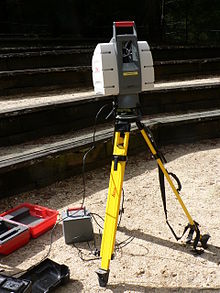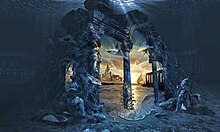Digital Media Concepts/Lost Cities
How Cities Are Lost
[edit | edit source]A lost city is defined as an uninhabitable area that contains physical decay. Abandoning these areas can be due to various reasons, such as geopolitical shifts, natural disasters, or even being ruined by human combat. Over a set period of time, these once-functional cities undergo an enormous change as buildings collapse and infrastructure deteriorates. The absence of human activity in these areas allows nature to reclaim what was once its territory.

Technology Used to Rediscover Cities
[edit | edit source]LiDAR
[edit | edit source]Light Detection and Ranging (LiDAR) is a remote sensing method that combines light and other data to measure ranges. That date then creates three-dimensional information on the shape and surface of the earth. A LiDAR is typically flown over certain areas to find certain anomalies that can indicate whether an ancient wall, ancient buildings, or even a road is buried beneath these areas.[1]
Thermal Imaging
[edit | edit source]Thermal imaging contains sensors which are are used to convert radiation into a clear image; this helps identify objects even in total darkness based on the measure of their temperatures. Besides the human temperature levels, it can also detect the difference in surface temperatures, which can indicate whether something is buried underneath.[2]
GPR
[edit | edit source]Ground-penetrating radar(GPR) uses various techniques and technologies to dive deeper into the composition, structure, and features located beneath the Earth's surface. It uses electromagnetic radar pulses in order to capture a better image of the material beneath the surface including, concrete, rock, ice and many other material. Even going as far as becoming the most popular techcnolgy claiming; “ In the last few decades, the technology has come so far that it’s now one of the most common approaches for surveying subsurface material”.[3]
Lost Cities Rediscovered and Their Impact on History
[edit | edit source]Machu Picchu
[edit | edit source]Machu Picchu, the city known as "Lost City of the Incas," is an ancient city located in the Mountains of Peru. Machu Picchu was a city built in the 15th century, likely under the rule of the Inca emperor Pachacuti. However, it was lost over time due to its remote location. However, in 1911, an American historian and explorer known as Hiram Bingham was able to rediscover this ancient city. It was an astonishing find due to its high level of engineering. Machu Picchu features a covert array of stone buildings, terraces, plazas, and temples, all harmoniously integrated into the stunning mountainous landscape. The rediscovery of this ancient city helped archaeologists piece together the history and culture of past civilizations, providing valuable insights into human history and heritage.[4]

Troy
[edit | edit source]Troy, an ancient city in Turkey that was rediscovered in 1870 by Heinrich Schliemann, is a site that holds very significant historical and archaeological significance. It is a place known for its pivotal role in the ancient Greek epic poem "Iliad" by Homer. According to legend, the war that left Troy abandoned was due to the Trojan prince Paris abducting Helen, the wife of the Spartan king Menelaus, leading to a Greek expedition to retrieve her, resulting in a ten-year siege of the city of Troy.[5]
Undiscovered Cities
[edit | edit source]
- Zerzura- An undiscovered oasis city.
- El Dorado- The legendary city of gold.
- Iram of the Pillars- The city mentioned in Arabian folklore.
- Shambhala- A kingdom mentioned in the Tibetan Buddhist tradition.
- Atlantis- Undiscovered island described by Plato.
References
[edit | edit source]- ↑ US Department of Commerce, National Oceanic and Atmospheric Administration. "What is LIDAR". oceanservice.noaa.gov. Retrieved 2024-03-24.
- ↑ "'Pinching myself': Explorer unearths, recreates ancient civilizations thought lost with new 3D tech". ABC7 San Francisco. 2023-12-01. Retrieved 2024-03-24.
- ↑ admin (2021-10-27). "How Does Ground Penetrating Radar (GPR) Work?". US Radar: Leading GPR Systems Innovators & Providers. Retrieved 2024-03-24.
- ↑ "Machu Picchu". HISTORY. 2023-06-29. Retrieved 2024-03-25.
- ↑ updated, Owen Jarus last (2022-02-08). "Ancient Troy: The City & the Legend". livescience.com. Retrieved 2024-03-25.
